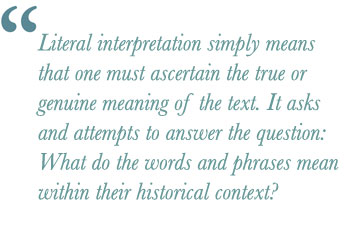How to Interpret the Bible
By David P. Diaz, Ed.D.
[Note: The following article served as the first draft of a chapter in the book: The Genesis Labyrinth (2nd ed., 2020).]

Introduction
One cannot
approach the Bible without having some grasp of the factors that are critical
to the interpretation of the text. As soon as the pages of the Bible are opened,
the reader is confronted with a text that must be interpreted. And yet the
languages and cultures of the Bible are so far removed from our own that we
often feel like outsiders when approaching the narrative. The following article
will shed light on some of the principles that guide the practice of interpreting
the Bible.
Hermeneutics
The science and art of interpreting the Bible is called hermeneutics. The late theologian, Bernard Ramm (1987, 6, 7), underscored the objective nature of hermeneutics and the need for rules when interpreting biblical texts:
When a person is familiar with the materials he reads or hears the process of understanding occurs without effort. Interpretation is present but it functions so spontaneously that it is not evident. When a person is confronted with strange materials his process of understanding becomes self-conscious. An effort is made to find rules that will guide the interpreter through such materials…. The conscious setting up of rules is hermeneutics.

But hermeneutics is not only about rules and facts, it is also an art and, as such, has a lot to do with the abilities of the practitioner. For example, physicians may all learn the same basic facts in medical school, but some end up being better practitioners than others. Their common goal is to successfully heal their patients, but this requires the deep understanding and application of the facts and principles they have learned. Some physicians are simply better at implementing these concepts than their peers. In like manner, the interpreter of the Bible approaches the text believing that it was meant to be understood but must still decode the message. That effort requires knowledge, as well as practice, to hone the necessary skills to become an accomplished interpreter.
According to Klein, et al. (2017, 43), the interpreter seeks “to bridge the linguistic, historical, social, and cultural gaps that exist between the ancient and modern worlds so that [he/she] may understand what texts mean.” Thus, to become a good interpreter, one must learn, and consistently practice, sound principles of hermeneutics.
While there is likely only one meaning (i.e., correct interpretation) conveyed in any
given passage of Scripture, there may be many misinterpretations. When we read the Bible, our separation
from the original culture, history, geography, and languages serves as an
obstacle to understanding the message.
Understanding the Language
Translation: The oldest
existing manuscripts of the Bible were written in Hebrew and Greek, languages that
are unfamiliar to most of us. These ancient texts have long been translated
into many other languages, including our own. Indeed, we depend on the
knowledge and expertise of modern translation committees to craft accurate
translations in a fluent and readable style. While this work is needed for our
eventual understanding of the original languages, it plays a limited role in
helping us to understand the cultural nuances of the Bible. The reader will
still need to study certain aspects of the ancient world to decipher the more
difficult passages.
Literary Devices: To properly interpret the Bible, it helps to understand the different styles or literary devices1 that are used to convey the narrative. Written language and speech can employ the following literary devices: symbolism, figurative language, imagery, paraphrasing, and allegory. There can also be conventions (i.e., customary features related to genre), parables (i.e., a short story, typically with a moral lesson at the end), anthropomorphic language (i.e., ascribing human qualities, emotions, or ambitions to God) and phenomenal language (describing events based on how they appear to the senses). The Bible contains all these devices, and more.
The discussion
below is meant to remind the reader of some of the important characteristics of
the language of the Bible that need to be considered when interpreting the
narratives. The following four sections were adapted from Ramm (1974).
Popular Language

The Bible was written in the “language
of man.” In other words, it was the language of the marketplace, of social
gatherings, and of everyday conversation. Because the Bible was written in a
popular style, we needn’t look for complex scientific concepts and axioms. The
Bible was not intended to deliver scientific truths to prescientific man. The
authors appealed to ancient beliefs about the world and not to current
understandings of science and the natural world.
Whatever truths the biblical authors were trying to communicate, they were not writing them to modern man but to their own contemporaries. That is, while the Bible was written for modern man, it wasn’t written to him. The Bible was written to ancient man in a language and within a culture that was understandable to him. The task of the interpreter is to decode that message through hermeneutics.
Phenomenal Language
The authors of the Bible described many aspects of the world by the way they appeared to the ordinary senses. This type of phrasing is commonly known as phenomenal language.2 For example, the prophet Isaiah spoke of the “four corners of the earth” (Isa. 11:12). Since to the naked eye the earth’s surface appears as a flat sheet, it has always been a practice to divide the surface of the earth into quarters. Today we still use the figure of speech “from the four corners of the globe” to express comprehensiveness.
If an author said, “the sun rose,” he,
too, was employing phenomenal language. The use of the language of appearance is
a natural and informal way to refer to the arrival of the sun in the morning or
its disappearance in the evening. Even though we now know that the earth is
rotating around the sun (rather than the sun rising or setting), we still
commonly use these expressions. There is no reason to believe the ancient
authors were trying to communicate the finer points of astronomy.
The use of
phenomenal language was a natural mode of expression for writers in ancient
times, just as it is today. This style represented a subconscious manner of
describing how things appeared to their unaided senses. Thus, phenomenal
language should not necessarily be considered erroneous regardless of what
ancient man believed about the nature of the world. While certain phrases may
have been “technically” inaccurate, it is unlikely that ancient authors were
interested in technical details when crafting their narratives. Whenever the
Bible speaks of the natural world, it does so in terms and concepts that were
understood by ancient man. This style rendered it easily understood by the
uneducated, the illiterate and, indeed, by every other ordinary person who
lived in that time and in that part of the ancient world.
Anthropomorphic Language
The biblical authors often ascribed human characteristics to God. When the writer says that God’s eyes see all or His ears hear all or His hands protect, it does not mean that the authors believed (or intended for anyone else to believe) that God had a human body with eyes, ears, and/or hands, any more than they believed God had wings!3
For example, in
Genesis, God is described as having feet and the ability to walk (3:8), a sense
of smell (8:21), the ability to regret and grieve (6:6), and a need to rest
(2:2). And yet we know that “God is spirit” (Jn. 4:24) and therefore doesn’t
have appendages. God is also all-powerful (Gen. 17:1) and therefore has no need
to rest.
Further, the Bible teaches that God is all-knowing (Ps. 139:2–4; 1 Jn. 3:20) and yet, when He sought out Adam in the Garden (of Eden), God asked, “Where are you?” (Gen. 3:9). When an omniscient (all-knowing) God asked this question of Adam, it was not for His own information, but was for the purpose of providing man an opportunity to come forward, confess, and repent. This allowed the readers of Genesis to more easily relate with God’s desire to instruct man, as well as mankind’s need to be accountable for their actions.
These are just
some of the literally hundreds of examples of anthropomorphic language in the
Bible. Once again, the writers of the Bible described the world in a natural,
uncomplicated way—a way that would be understood by the people to whom their
message was originally written. By ascribing human characteristics to God, the
writer could make an infinite God seem more apprehensible to finite humans.
Figurative/Symbolic Language
Examples of figurative language in the
Bible include metaphor—Hosea 7:8, “Ephraim is a flat
loaf not turned over”; simile, Genesis 33:10, “For to
see your face is like seeing the face of God”; and hyperbole,
John 21:25, “Jesus did many other things as well. If every one of them were
written down, I suppose that even the whole world would not have room for the
books that would be written.”
In the New Testament, Jesus is recorded saying to the Jews, “Destroy this temple, and I will raise it again in three days” (Jn. 2:19). The Jewish religious leaders thought He was claiming the ability to reconstruct the temple in just three days. The Jews were quick to point out that the construction of the temple had already taken forty-six years and was still not finished (v. 20). They didn’t understand Jesus’ use of metaphor. In this case, the following verse explained the literal meaning of Jesus’ comment: “But the temple he had spoken of was his body” (v. 21). Thus, Jesus was predicting his literal death and resurrection through the use of figurative language (“[d]estroy this temple and I will raise it again in three days”). It becomes evident then, that Jesus employed both literal and figurative language to convey literal meanings or truths, and so did the Bible authors.
Literal Method of Interpretation
The literal method of interpretation is
the most common practice in interpreting all literature. Ramm (1976, 123) rightly noted: “Whenever
we read a book, an essay, or a poem we presume the literal sense in the
document until the nature of the literature may force us to another level.” Ramm
further explained, “The non-literal is always a secondary meaning which
presumes an already existing literal understanding of literature” (123).
Indeed, literary devices are useful precisely because they leverage or play off
the literal understandings of words.

The goal of hermeneutics is to understand the literal meaning4 of the text. Unfortunately, the term literal is an often used but not-too-often-understood term that conveys the idea of naïve, gross literalism. As a result, my use of the term “literal interpretation” requires a brief explanation. Literal interpretation simply means that one must ascertain the true or genuine meaning of the text. It asks and attempts to answer the question: What do the words and phrases mean within their historical, geographical, and literary contexts? This is not always apparent. Nevertheless, whether words are used literally or figuratively, within the context of the writing, the intent is to covey a literal truth or message.
For example, when Jesus said, “I am the
bread of life” (Jn. 6:48), he was using a figurative expression to illustrate a
literal truth. Just as bread provides physical sustenance, Jesus came to
provide spiritual sustenance, which leads to eternal life. So, the message, or
truth, being conveyed is almost always a literal one.
Literal
interpretation recognizes all literary devices including nuance, plays on
words, figures of speech, and multiple meanings (e.g., double entendre). All
cultural expressions, anthropomorphisms, phenomenal language, symbols, and
other devices must be recognized and their literal meanings, or message, understood.
Interpretation v.
Application

The interpreter must recognize that although the bible was written for us, it wasn’t in every case written to us. It was written to certain people,
at a certain time, and for certain reasons. The interpreter must distinguish
between interpretation and application, between what it meant to those to whom
it was written, and what it means for us today.
While some things in the Bible are universally applicable, others are not. For example, God made the following promise to King David: “A thousand may fall at your side and ten thousand at your right hand, but it shall not approach you” (Psa. 91:7 [NASB]). He was promising to protect David from his enemies during battle and from all other forms of harm. Does that mean that every true believer should expect to be protected from his enemies when he goes to war? Does it mean that all believers will be kept from sicknesses? In other words, was this a universal promise for every believer in history? Of course not! With a little reflection, most people will see that certain promises and statements in the Bible were intended specifically for certain people and can’t be universally applied. Some commands were written to a specific people, at a specific time, and in a specific place, and do not necessarily apply to other people, times, and places. It makes no sense for us to think that every word of an ancient text applies to all our current situations.
On the other hand, there are many examples of assurances that are clearly
universal: “For I am convinced that neither death, nor life, nor angels, nor
principalities, nor things present, nor things to come, nor powers, nor height,
nor depth, nor any other created thing, will be able to separate us from the
love of God, which is in Christ Jesus our Lord” (Rom. 8:38–39a). In this verse,
Paul establishes the certainty that all true believers will never be separated
from the love of God because they have a personal relationship with Jesus
Christ.
How to Interpret the Bible
Therefore, before applying the words and teachings to one’s own life, one must first answer the question: “What did the passage mean to those to whom it was written?” I have found that the easiest way to begin interpreting the Bible is to increase one’s skill as an observer. This can be accomplished by examining the text with an eye for detail. Like Sherlock Holmes investigating a case for Scotland Yard, the interpreter must pay meticulous attention to detail as she reads and rereads the passages. To guide the interpreter in this endeavor, there are six questions that can be asked and answered of every passage that is being interpreted:

- Who? This question refers to the people mentioned within the text. Who are they? What do they say? What is said about them? What is known about them? You might use a Bible dictionary to learn more about the characters or a concordance5 to trace all appearances of the person’s name in the Bible.
- What? This question refers to what is happening. The interpreter should be able to describe the setting and what is happening within the setting. Who is included, and what were they asked to do?
- Where? What is the physical location of the event? In answering this question, one can make good use of maps, either the ones that come inside the Bible or those found in Bible atlases. One might also look up the location in a Bible dictionary, Bible encyclopedia, or other supplementary aid. Learning about the geographic background of a passage will often illuminate its meaning.
- When? At what time of the day or year was the event happening? Was it morning, midday, or evening? Was it a special day, holiday, or sacred day and, if so, what was its significance? Looking up the purpose or importance of certain days or holidays can often illustrate the import of an occasion.
- Why? What was the purpose for what was happening? Was there a lesson, command, or teaching for the people who were there? Jesus often used parables to teach lessons to the people. Understanding what these parables taught the original listeners is critical to understanding how these lessons apply to our own lives. Biblical commentaries6 can be consulted when attempting to understand difficult passages.
- What does the passage mean to me? The five questions above are related to the meaning of the text. Asking and answering these questions will help the interpreter understand what a passage meant to the original audience. By understanding the author’s intended meaning, one can then answer the sixth or application question: “What does it mean to me?” The process of application helps one understand what to do with, or how to use, the Bible to enhance lives today. Jack Kuhatschek in his Applying the Bible (as cited in Klein et al. 2017) boils application down to three steps: [1] “understand the original situation, [2] determine the broader principle that the biblical application reflects, and [3] apply that general principle to situations we face” (610). In other words, once the interpreter understands what the passage meant and how it applied to those for whom it was originally written, then she can determine the general principle that will be applicable to everyone, including herself.
Conclusion
As with other ancient literature, interpreting
the Bible can be difficult in the sense that it will require some extra effort
to understand what the authors meant to convey to their readers. The
differences in language, culture, historical setting, customs, geography, and
more, will make the interpretation uncertain in some cases.
Our modern translations of the Bible
have done some of the work for us. In the process of translating, the experts
have determined the word meanings based on their understanding of the
above-mentioned principles. Nevertheless, the average reader will still need to
study the background, understand the literary devices, and consistently apply
the principles of hermeneutics. Even then, our interpretations should be held
with a certain amount of humility. I work under two basic assumptions: (1)
Everyone should have good reasons for the interpretations they hold. But, (2) nobody
is infallible. The sooner people can disabuse themselves of the notion they
will reach the end of their lives with all their biblical interpretations
intact, the sooner they can develop empathy and tolerance for the interpretations
of others.
About the Author
David P. Diaz, Ed.D. is the publisher and owner of Things I Believe Project. An educator and author, Dr. Diaz has a lifelong love of learning. His pen name (“Don Quixote” or, “DQ”) comes from his love of chasing windmills (i.e., truth and other ideals) and his penchant for tongue-in-cheek humor: “Don Quixote was developing his arguments in such an orderly and lucid way that for the time being none of those listening could believe he was a madman.”
References Cited
Klein, W. W., C. L. Blomberg, and R. L. Hubbard. Introduction to Biblical Interpretation. 3rd ed. Grand Rapids, MI: Zondervan, 2017.
Ramm, B. L. The Christian View of Science and Scripture. Grand Rapids, MI: Eerdmans, 1974.
Ramm, B. L. Protestant Biblical Interpretation: A Textbook of Hermeneutics. 3rd ed. Grand Rapids, MI: Baker Book House, 1976.
Ramm, B. L. Hermeneutics. Grand Rapids, MI: Baker Book House, 1987.